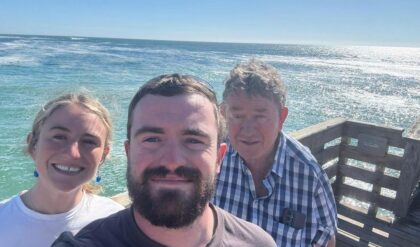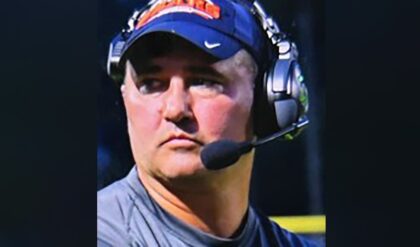
While filming “Panic Room,” Jodie Foster once did 110 takes of a single scene.
Speaking at a Netflix Emmy FYSee event at Raleigh Studios on Friday night, Foster explained that while working with directors like David Fincher was “the greatest film school,” her style behind the camera is a markedly different approach.
“Directors bounce back and forth between controlling and freedom. I’m the fast and furious one,” Foster said. “I like the energy of having the actors understand that we are so prepared and we’ve all organized and orchestrated everything, whether it’s the camera moves or the visuals as much as possible. We all know ahead of time what we’re going to do because I want them to feel like they’re firing. They do two takes and they move on to the next thing. It gives the acting a different energy, because they can’t second-guess themselves.”
Foster’s panel partner for the evening, Jason Bateman, took a similar path from working as a child actor to now entering another phase of his career as a director of TV. Foster, Bateman, and the evening’s moderator, Chris Ryan from The Ringer, discussed the two performers’ first inklings that they might want to do more than act. For Bateman, he learned the model of the actor-director from working with Michael Landon on “Little House on the Prairie.”
“It was very helpful for me to see that a call sheet can get shot without yelling. It can be done well without being precious, but just by simply encouraging and being supportive and staying out of the way of something that might be better than what you thought,” Bateman said.
When Ryan asked if they had taken any advice or extra knowledge from their time as actors, Bateman grinned as he shared a tip he’s noticed in his own career, especially when directing episodes of “Ozark.”
While filming “Panic Room,” Jodie Foster once did 110 takes of a single scene.
Speaking at a Netflix Emmy FYSee event at Raleigh Studios on Friday night, Foster explained that while working with directors like David Fincher was “the greatest film school,” her style behind the camera is a markedly different approach.
“Directors bounce back and forth between controlling and freedom. I’m the fast and furious one,” Foster said. “I like the energy of having the actors understand that we are so prepared and we’ve all organized and orchestrated everything, whether it’s the camera moves or the visuals as much as possible. We all know ahead of time what we’re going to do because I want them to feel like they’re firing. They do two takes and they move on to the next thing. It gives the acting a different energy, because they can’t second-guess themselves.”
Foster’s panel partner for the evening, Jason Bateman, took a similar path from working as a child actor to now entering another phase of his career as a director of TV. Foster, Bateman, and the evening’s moderator, Chris Ryan from The Ringer, discussed the two performers’ first inklings that they might want to do more than act. For Bateman, he learned the model of the actor-director from working with Michael Landon on “Little House on the Prairie.”
“It was very helpful for me to see that a call sheet can get shot without yelling. It can be done well without being precious, but just by simply encouraging and being supportive and staying out of the way of something that might be better than what you thought,” Bateman said.
When Ryan asked if they had taken any advice or extra knowledge from their time as actors, Bateman grinned as he shared a tip he’s noticed in his own career, especially when directing episodes of “Ozark.”
“I’m garbage when I’m really nervous. So I take that to when I’m directing. We all do our best when we’re relaxed and when we’re feeling good. Part of directing is acting and that is why actors make decent directors,” Bateman said. “Not only do you understand what an actor needs, but we’re professional liars as actors. One of the easy tricks is to go up and if you want an actor to do something, compliment on them having just done it and you want them to do a little more of it. You gotta think of what’s the positive way to say this as opposed to ‘Stop doing that,’ because that’s gonna make them nervous.”

Being on the other side of the process helped both Bateman and Foster realize that, as important as preparation can be, part of the job is shedding preconceived notions of how a certain line can be delivered or an emotional can be conveyed.
“The director will come in and give you a note and you know that note is coming from the place of he/she are just telling me this because I’m doing it differently than they imagined. I know the audience didn’t read the script, so they’re not going to have a preconceived notion. They might not see that as a bad thing,” Bateman said. “So I’ve tried to be really fair with that, with coming up and receiving a performance that could be wildly different than what I assumed. I know that I’ve hired someone with great taste, so go for it.”
“I think you’re better off controlling everything else, controlling all the images,” Foster added. “And making sure you cast the right person, that you’re absolutely certain and you’ve had those conversations before you ever arrived about what your intentions are and what you’re looking for from your actors. You can’t change the weather and you can’t change actors. You only have 20 minutes and you can’t change an actor in 20 minutes. So sometimes you have to find ways around it.”
Having worked extensively in both TV and film, most recently directing the “Black Mirror” installment “Arkangel,” Foster talked about how her love of the form combines the best of what she’s experienced in both arenas.
“What the best television can do is it pulls from the beauty of features in that everything is meaningful. Every lens choice, every piece of casting, every time somebody puts a piece of sugar in their tea, every spoon, there’s a reason that’s there,” Foster said. “That hasn’t always been true in television. Sometimes it’s, ‘we’re going to put a bunch of people in a room and it’s going to be funny and circular and we’re going to do that week after week.’ But I think television has really come to understand the beauty of building narrative structure.”
It might seem like an arbitrary distinction at times, but that structure has informed the way Bateman approaches the storytelling aspects of directing for TV. “Ozark” being available for binge-watching helped shape how he crafted some of the tinier details of the four Season 1 episodes he directed.
 “Black Mirror: ArkAngel”Christos Kalohoridis / Netflix
“Black Mirror: ArkAngel”Christos Kalohoridis / Netflix
“You can predict, assume, hope, expect, perhaps, that people are gonna bite off three or four episodes at a time,” Bateman said. “Do I really need to have that person say that line of exposition in a close-up or can I have it play off-camera? Because we did say it in the last episode and if the person just watched that last episode, they’re gonna see this close-up and be like, ‘Guy, I got it. Come on!’ You don’t want that ding against you. It is much more of a feature-type of approach, both in writing and shooting and editing, where you are giving the audience the benefit of the doubt that they’re engaged and that they’ve made an appointment to see this and to gobble up a larger chunk of it. It allows you to be more subtle.”
While filming “Panic Room,” Jodie Foster once did 110 takes of a single scene.
Speaking at a Netflix Emmy FYSee event at Raleigh Studios on Friday night, Foster explained that while working with directors like David Fincher was “the greatest film school,” her style behind the camera is a markedly different approach.
“Directors bounce back and forth between controlling and freedom. I’m the fast and furious one,” Foster said. “I like the energy of having the actors understand that we are so prepared and we’ve all organized and orchestrated everything, whether it’s the camera moves or the visuals as much as possible. We all know ahead of time what we’re going to do because I want them to feel like they’re firing. They do two takes and they move on to the next thing. It gives the acting a different energy, because they can’t second-guess themselves.”
Foster’s panel partner for the evening, Jason Bateman, took a similar path from working as a child actor to now entering another phase of his career as a director of TV. Foster, Bateman, and the evening’s moderator, Chris Ryan from The Ringer, discussed the two performers’ first inklings that they might want to do more than act. For Bateman, he learned the model of the actor-director from working with Michael Landon on “Little House on the Prairie.”
“It was very helpful for me to see that a call sheet can get shot without yelling. It can be done well without being precious, but just by simply encouraging and being supportive and staying out of the way of something that might be better than what you thought,” Bateman said.
When Ryan asked if they had taken any advice or extra knowledge from their time as actors, Bateman grinned as he shared a tip he’s noticed in his own career, especially when directing episodes of “Ozark.”
“I’m garbage when I’m really nervous. So I take that to when I’m directing. We all do our best when we’re relaxed and when we’re feeling good. Part of directing is acting and that is why actors make decent directors,” Bateman said. “Not only do you understand what an actor needs, but we’re professional liars as actors. One of the easy tricks is to go up and if you want an actor to do something, compliment on them having just done it and you want them to do a little more of it. You gotta think of what’s the positive way to say this as opposed to ‘Stop doing that,’ because that’s gonna make them nervous.”

Being on the other side of the process helped both Bateman and Foster realize that, as important as preparation can be, part of the job is shedding preconceived notions of how a certain line can be delivered or an emotional can be conveyed.
“The director will come in and give you a note and you know that note is coming from the place of he/she are just telling me this because I’m doing it differently than they imagined. I know the audience didn’t read the script, so they’re not going to have a preconceived notion. They might not see that as a bad thing,” Bateman said. “So I’ve tried to be really fair with that, with coming up and receiving a performance that could be wildly different than what I assumed. I know that I’ve hired someone with great taste, so go for it.”
“I think you’re better off controlling everything else, controlling all the images,” Foster added. “And making sure you cast the right person, that you’re absolutely certain and you’ve had those conversations before you ever arrived about what your intentions are and what you’re looking for from your actors. You can’t change the weather and you can’t change actors. You only have 20 minutes and you can’t change an actor in 20 minutes. So sometimes you have to find ways around it.”
Having worked extensively in both TV and film, most recently directing the “Black Mirror” installment “Arkangel,” Foster talked about how her love of the form combines the best of what she’s experienced in both arenas.
“What the best television can do is it pulls from the beauty of features in that everything is meaningful. Every lens choice, every piece of casting, every time somebody puts a piece of sugar in their tea, every spoon, there’s a reason that’s there,” Foster said. “That hasn’t always been true in television. Sometimes it’s, ‘we’re going to put a bunch of people in a room and it’s going to be funny and circular and we’re going to do that week after week.’ But I think television has really come to understand the beauty of building narrative structure.”
It might seem like an arbitrary distinction at times, but that structure has informed the way Bateman approaches the storytelling aspects of directing for TV. “Ozark” being available for binge-watching helped shape how he crafted some of the tinier details of the four Season 1 episodes he directed.
 “Black Mirror: ArkAngel”Christos Kalohoridis / Netflix
“Black Mirror: ArkAngel”Christos Kalohoridis / Netflix
“You can predict, assume, hope, expect, perhaps, that people are gonna bite off three or four episodes at a time,” Bateman said. “Do I really need to have that person say that line of exposition in a close-up or can I have it play off-camera? Because we did say it in the last episode and if the person just watched that last episode, they’re gonna see this close-up and be like, ‘Guy, I got it. Come on!’ You don’t want that ding against you. It is much more of a feature-type of approach, both in writing and shooting and editing, where you are giving the audience the benefit of the doubt that they’re engaged and that they’ve made an appointment to see this and to gobble up a larger chunk of it. It allows you to be more subtle.”
As vital as working with actors are to the art of directing TV, Bateman explained that the process is a comprehensive one. For him, utilizing key decisions in color grading and sound mixing are unsung vital components of crafting an episode.
“It sets the table for the meal that’s about to put in front of you. If the table is set up with a red-and-white checkerboard tablecloth, I’m ready for pizza. You don’t even realize it. It’s an important thing for me as a viewer and I’m surprised how many directors really don’t engage as much as they are allowed to,” Bateman said. “A different analogy, working that mixing board: ‘Bring up this part to a 3, because I’m going to do a 5 with that one. Downstream, there’s gonna be a 7 over here because the score is going to be really emotional. So you, actor, I don’t need you to do as much because of the piano.’ I’m inspired by the directors that seem to do a 360-degree environment and experience-shaping for the audience.”
Finally, when it came to handling the demands of a shooting schedule, Foster had one piece of advice that brought the whole night full-circle: work with kids.
“Actually, working with children is very helpful. If they don’t want to throw the spaghetti again, they’re just not going to,” Foster said. “You have to learn to think on your feet, because if they’re not feeling it, it’s just not going to happen. So, when you say to the little seven-year-old boy, ‘At the end of the line, I’d like you to button your shirt’ and he does not do that two takes in a row, three takes in a row, you gotta go move on and try something else. I think children are really good training for how to deal with adult actors.”



